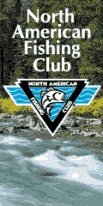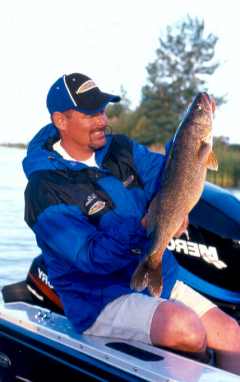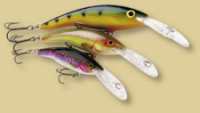
|
|||||

Free 90 day Risk free trial offer click here 
|
Cold front tactics by Rick Olsen Mother Nature can destroy the best made plans. You could be on a premier
walleye lake, at a peak time of the year, with all of the latest gear,
and still come up empty handed after a dreaded cold front comes rolling
through.
The period following is usually typified by clear blue skies, low humidity, and high pressure. For whatever reason, this period can bring walleye activity to a grinding halt. It could be the high pressure, it could be the added light, or it could be the fact that they’ve already eaten everything they needed to get by for a couple days. Nobody knows for sure, but it doesn’t really matter as long as you know it happens. Knowing that it does happen will allow you to react accordingly, and adjust where and how you have been fishing, if necessary. The next consideration is measuring the severity of the front, and includes whether or not it was accompanied by an electrical storm, and how drastic the temperature has changed. Angling during an electrical storm is absolutely crazy, and can be downright phenomenal, but is not worth the risk, ever. The fact that it can be so good, has kept anglers out longer than they should have, and some haven’t made it back. Although the action can be pretty intense before an electrical storm passes, the period following can be among the toughest you’ll face. While a cold front by itself has at least a small chance to change things for the worse, a front accompanied by an electrical storm can really shut things down. Whether it’s all that electricity, or the fact that electrical storms are often followed by big temperature and pressure changes, fronts with lighting can be expected to have a detrimental effect. Regardless of the severity of a cold front, the first thing to do is to relax, and not panic. If you’ve been on fish and are worried about losing what you’ve had, stop worrying and get fishing. It would be a mistake to immediately believe that all is lost, and you might as well stay home. Even if a front has had an effect, there are ways to deal with it.If you’ve been on fish, the first thing to do is get back there and see what’s happening. If you get back and find conditions similar to what they were, you better drop ol’ marble eyes a line and see if he’s had an attitude change. If conditions have changed, like the notable absence of bait and fish on a graph, it may be time for altering your game plan. One of the first reactions to a big change is to look a little deeper. Deeper is relative term, and may mean a few feet, to twenty feet deeper or more. After a cold front passes, many fish will head for deeper water, where they can hole up until better conditions return. Although many of those fish will probably be turned off, chances are that a least a few can be caught. Another factor is that while there may be plenty of fish shallow, there are almost always some deep. Deep fish are less effected than those that are shallow, and they may continue to feed in the same places, at the same times, as they did prior to the passing of front. Changes in presentations may become necessary, especially if what you’ve been using is getting little or no results. Small changes, like using a smaller bait, may be all that is necessary.
If you’ve been using live bait, you may need to change bait types, like going from a crawler to a leech. Another option would be forgoing both crawlers and leeches for a minnow, like a red tail chub. Red tails will work their tails off for you, and can be too much for sluggish walleyes to resist. All in all, cold fronts do have their effect, but by making the right adjustments you can continue to catch fish under the worst conditions. In fact, you just might surprise yourself by how good it can really be. International Fishing Banner Exchange Please visit these site sponsors |
||||
|---|---|---|---|---|---|

